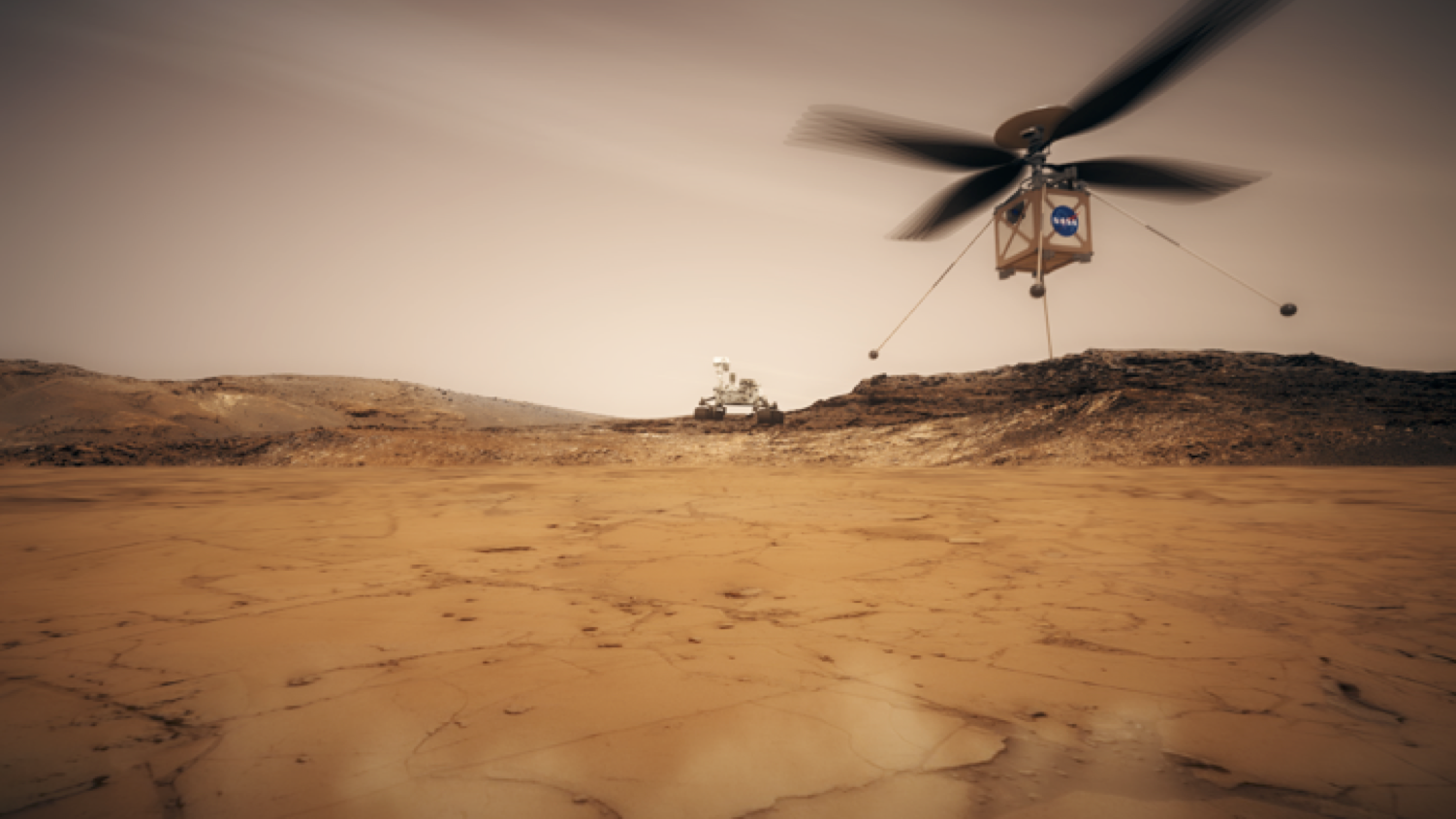Mars Helicopter Project

Mars Helicopter Project for the NASA Mars 2020 Mission is a JPL-led collaborative effort with NASA Ames, Langley, and Glenn Research Centers and AeroVironment, Inc.
Although aerial vehicle concepts for Mars have been proposed since the earliest days of space exploration, the full challenges of flight in the extremely thin, cold, and primarily CO2–based atmosphere of Mars only become apparent after the Viking Lander missions of the 1970s. For approximately two decades afterwards only Mars airplane concepts were studied. Savu and Trifu [12] were among the first to consider the design implications of Mars rotorcraft; however, their work was not carried forward beyond its initial study.
In 2000, Stanford University and JPL, as a tangential off–shoot of Stanford's NASA NIAC–sponsored micro–rotorcraft work attempted a proof–of–concept test of a small rotor under Mars–like atmospheric conditions in a JPL vacuum chamber [7]. No experimental results were published from this initial proof–of–concept test, though video was released at the time. Independently, at approximately the same time, a series of papers were published by NASA Ames Research Center studying the technical challenges of various Mars rotorcraft configurations and other vertical lift planetary aerial vehicles [1, 18, 24, 20].
In 2000, Sikorsky Aircraft and NASA Ames Research Center co–sponsored the AHS International Student Design Competition on the topic of a Mars rotorcraft. Thompson [15] and Datta et al. [3] are summary papers describing respectively the Georgia Tech and University of Maryland Mars rotorcraft design entries. In 2002, the first experimental results for a rotor hover test under Mars–like conditions were published [26] as well as initial CFD predictions [32]. Over the next decade–and–a–half, papers continued to be occasionally published by NASA Ames [19, 25, 21, 22, 23] on the topic of planetary aerial vehicles, both fixed–wing and vertical lift aerial vehicles.
As time went on, interest slowly grew, and papers by other authors, organizations, and countries began to be published on Mars rotorcraft and vertical lift planetary aerial vehicles [17, 13]. In 2014, JPL and AeroVironment published an initial paper on what would ultimately become the conceptual foundation for the current Mars Helicopter effort [2]. The concept has significantly evolved over the past few years but retains many of its core features.
Among some of the analytical and experimental work conducted by the Aeromechanics Office that has been performed in support of, or in complement to, the Mars Helicopter effort has been: rotor performance estimates using a rotorcraft comprehensive analysis [31, 34, 35]; prediction and measurement of flow recirculation generated by rotors in the JPL 25 Ft. Diameter Space Simulator [33]; system–ID analysis support of Mars Helicopter risk reduction model and engineering development model flight dynamics testing in the JPL 25 Ft. Diameter Space Simulator [29, 30]; edgewise forward–flight wind tunnel testing of a surrogate rotor system at Mars–like atmospheric densities in the NASA Ames/ASU Planetary Aeolian Laboratory large low–pressure chamber. Additionally, NASA Ames and Langley rotary–wing vehicle expertise also supported design reviews of the Mars Helicopter during several stages of its development.
In addition to the Mars Helicopter, the Aeromechanics Office has also been active over the past two decades in studying other planetary aerial vehicles.
Mars Helicopter/Rotorcraft References:
- [1] E.W. Aiken, R.A. Ormiston, and L.A. Young. Future directions in rotorcraft technology at Ames research center. In Proc. American Helicopter Society Annual Forum, Virginia Beach, VA, 2000.
- [2] J. Balaram and P. T. Tokumaru. Rotorcrafts for Mars exploration. In Proc. International Planetary Probe Workshop, Pasadena, CA, 2014. LPI Contribution No. 1795.
- [3] A. Datta, B. Roget, D. Griffiths, G. Pugliese, J. Sitara– man, J. Bao, L. Liu, and O. Gamard. Design of the Martian autonomous rotary–wing vehicle. In Proc. AHS Specialist Meeting on Aerodynamics, Acoustics, and Test and Evaluation, San Francisco, CA, 2002.
- [7] I. Kroo and P. Kunz. Development of the Mesicopter: A miniature autonomous rotorcraft. In Proc. American Helicopter Society Vertical Lift Aircraft Design Conf., San Francisco, CA, 2000.
- [12] G. Savu and O. Trifu. Photovoltaic rotorcraft for Mars missions. In Proc. Joint Propulsion Conf. and Exhibit, San Diego, CA, 1995.
- [13] H. Song and C. Underwood. A Mars VTOL aerobot – preliminary design, dynamics and control. In Proc. IEEE Aerospace Conference, 2007. [15] B. Thompson. Full throttle to Mars. Rotor & Wing, Phillips Business Information, LLC, Potomac, MD, 2001.
- [16] N. Tsuzuki, S. Sato, and T. Abe. Conceptual design and feasibility for a miniature Mars exploration rotor– craft. In Proc. International Congress of the Aeronautical Sciences, 2004.
- [18] L. A. Young. Vertical lift – not just for terrestrial flight. In Proc. AHS/AIAA/RaeS/SAE International Powered Lift Conference, Arlington, VA, 2000.
- [19] L. A. Young and E. W. Aiken. Vertical lift planetary aerial vehicles: Three planetary bodies and four conceptual design cases. In Proc. European Rotorcraft Forum, Moscow, Russia, 2001.
- [20] L. A. Young, R. T. N. Chen, E. W. Aiken, and G. A. Briggs. Design opportunities and challenges in the development of vertical lift planetary aerial vehicles. In Proc. American Helicopter Society International Vertical Lift Aircraft Design Conference, San Francisco, CA, 2000.
- [21] L. A. Young, E. W. Aiken, V. Gulick, R. Mancinelli, and G. A. Briggs. Rotorcraft as Mars scouts. In Proc. IEEE Aerospace Conf., Big Sky, MT, 2002.
- [22] L. A. Young, E. W. Aiken, and G. A. Briggs. Smart rotorcraft field assistants for terrestrial and planetary science. In Proc. IEEE Aerospace Conference, Big Sky, MT, 2004.
- [23] L. A. Young, P. Lee, G. Briggs, and E. Aiken. Mars rotorcraft: Possibilities, limitations, and implications for human/robotic exploration. In Proc. IEEE Aerospace Conference, Big Sky, MT, 2005.
- [24] L. A. Young et al. Use of vertical lift planetary aerial vehicles for the exploration of Mars. In NASA Headquarters and Lunar and Planetary Institute Workshop on Mars Exploration Concepts, Houston, TX, 2000.
- [25] L. A. Young et al. Engineering studies into vertical lift planetary aerial vehicles. In Proc. AHS International Meeting on Advanced Rotorcraft Technology and Life Saving Activities, Utsunomiya, Tochigi, Japan, 2002.
- [26] L. A. Young et al. Experimental investigation and demonstration of rotary–wing technologies for flight in the atmosphere of Mars. In Proc. American Heli– copter Society Annual Forum Proceedings, Montreal, Canada, 2002.
- [27] Ament, G., Koning. W. J. F., "Isolated Rotor Forward Flight Testing from One Atmosphere Down to Martian Atmospheric Densities," AHS Technical Meeting on Aeromechanics Design for Vertical Lift, Holiday Inn at Fisherman's Wharf, San Francisco, CA, January 16–18, 2018.
- [28] Balaram, J., Canham, T., Duncan, C., Golombek, M., Grip, H.F., Johnson, W., Justin Maki, J., Quon, A., Stern, R., and David Zhu, D., "Mars Helicopter Technology Demonstrator," 2018 AIAA Guidance, Navigation, and Control Conference, AIAA SciTech Forum, 8–12 January 2018, Kissimmee, Florida.
- [29] Grip, H., Johnson, W., Malpica, C., Scharf, D., Mandic, M., Young, L., Allany, B., Mettler, B., San Martin, M., "Flight Dynamics of a Mars Helicopter," 43rd European Rotorcraft Forum, Milan, Italy, September 12–15, 2017.
- [30] Grip, H.F., Scharf, D.P., Malpica, C.., Johnson, W., Mandic, M., Singh, G., Young, L., "Guidance and Control for a Mars Helicopter," 2018 AIAA Guidance, Navigation, and Control Conference, AIAA SciTech Forum, 8–12 January 2018, Kissimmee, Florida.
- [31] Koning, W. J. F., Johnson, W., Allan, B. G., "Generation of Mars Helicopter Rotor Model for Comprehensive Analyses," AHS Technical Meeting on Aeromechanics Design for Vertical Lift, Holiday Inn at Fisherman's Wharf, San Francisco, CA, January 16–18, 2018.
- [32] Corfeld, K., Strawn, R., and Long, L., "Computational Analysis of a Prototype Martian Rotorcraft Experiment," AIAA–2002–2815, 20th AIAA Applied Aerodynamics Conference, St. Louis, Missouri, June 24–26, 2002.
- [33] McCoy, M., Wadcock, A., Young, L., "Documentation of the Recirculation in a Closed–Chamber Rotor Hover Test", NASA/TM–2016–219162.
- [34] Koning, W. J. F., Romander, E. A., and Johnson, W., "Low Reynolds Number Airfoil Evaluation for the Mars Helicopter Rotor," AHS International 74th Annual Forum & Technology Display, Phoenix, Arizona, May 14–17, 2018.
POINT OF CONTACT
Larry Young
NASA Ames Research Center
Moffett Field CA 94035–1000
